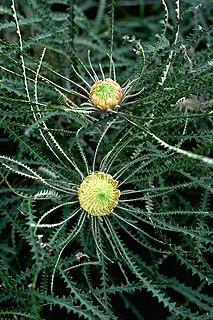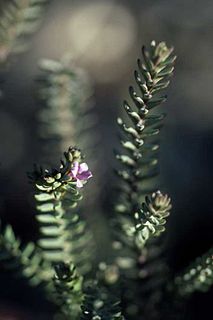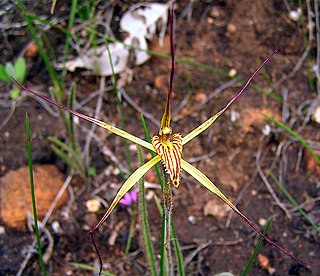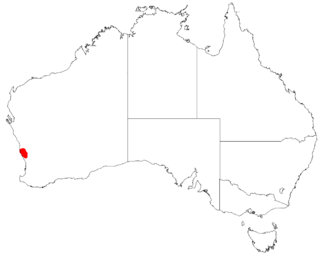
Anigozanthos is a genus of Southwest Australian plants of the bloodwort family Haemodoraceae. The 11 species and their subspecies are commonly known as kangaroo paw or catspaw, depending on their size, and the shape and color of their flowers. A further species, previously identified as Anigozanthos fuliginosus, was separated to a monotypic genus as Macropidia fuliginosa.

Banksia calophylla is a species of shrub that is endemic to Western Australia. It has a fire-tolerant, underground stem, pinnatifid leaves that have woolly hairs on the lower surface and heads of thirty to forty-five yellowish brown flowers surrounded by hairy bracts.

Banksia prolata is a species of bushy shrub that is endemic to Western Australia. It has linear, serrated or pinnatifid leaves, yellow flowers in heads of between 150 and 250, and egg-shaped follicles.
Banksia montana, commonly known as the Stirling Range dryandra, is a species of shrub that is endemic to the Stirling Range in Western Australia. It has hairy stems, linear pinnatisect leaves with twisted, triangular lobes, yellow flowers in heads of about sixty and reddish-brown follicles.

Banksia mucronulata, commonly known as swordfish dryandra, is a species of shrub that is endemic to Western Australia. It has spreading, hairy stems, linear, deeply pinnatifid leaves with sharply-pointed lobes, pale yellow to cream-coloured flowers in heads of between 80 and 180, and egg-shaped follicles.
Persoonia spathulata is a species of flowering plant in the family Proteaceae and is endemic to the south-west of Western Australia. It is an erect to spreading shrub with hairy young branchlets, spatula-shaped leaves, and yellow flowers arranged singly or in pairs on a rachis up to 2 mm (0.079 in) long that continues to grow after flowering.
Persoonia leucopogon is a species of flowering plant in the family Proteaceae and is endemic to Western Australia. It is an erect to low-lying shrub with branchlets that are densely hairy when young, narrow oblong to narrow elliptic leaves and yellow or greenish yellow flowers borne singly or in groups of up to four on a rachis up to 2 mm (0.079 in) long.
Persoonia pungens is a species of flowering plant in the family Proteaceae and is endemic to the south-west of Western Australia. It is an erect to spreading or low-lying shrub with densely hairy young branchlets, twisted elliptic to oblong, sharply-pointed leaves, and glabrous, bright yellow flowers borne in groups of up to five.

Eremophila veronica, commonly known as veronica-like eremophila, is a flowering plant in the figwort family, Scrophulariaceae and is endemic to Western Australia. It is a low, spreading shrub with small, crowded leaves and lilac-coloured flowers which have a short petal tube and spreading petal lobes.

Caladenia caesarea subsp. caesarea, commonly known as the mustard spider orchid, is a plant in the orchid family Orchidaceae and is endemic to the south-west of Western Australia. It has a single spreading, hairy leaf and up to three mustard-coloured flowers with red stripes. It was originally described as a subspecies of Caladenia filamentosa but the rich colour of its flowers and prominent labellum separate it from that species.

Caladenia caesarea subsp. maritima, commonly known as the cape spider orchid, is a plant in the orchid family Orchidaceae and is endemic to the south-west of Western Australia. It has a single spreading, hairy leaf and up to three small mustard-coloured flowers with red stripes. It is only known from a small coastal area near Cape Leeuwin where it grows in clumps of ten or more.
Caladenia caesarea subsp. transiens, commonly known as the dwarf mustard spider orchid, is a plant in the orchid family Orchidaceae and is endemic to the south-west of Western Australia. It has a single spreading, hairy leaf and up to three small lemon-yellow flowers with red stripes. It is only known from a single small population near the town of Williams.
Dasymalla axillaris, commonly known as native foxglove or woolly foxglove, is a flowering plant in the mint family Lamiaceae and is endemic to Western Australia. It is a small, diffuse shrub with its branches, leaves and some of its flower parts densely covered with white, woolly hairs. The flowers are a shade of red and tube-shaped with the stamens and style extending beyond the end of the five petals.

Quoya dilatata is a flowering plant in the mint family Lamiaceae and is endemic to Western Australia. It is a low, spreading shrub with its branches and leaves densely covered with a layer of white, woolly hairs. The leaves are wrinkled or crinkly and the tube-shaped flowers are orange-red and hairy on the outside.
Kunzea affinis is a flowering plant in the myrtle family, Myrtaceae and is endemic to the south-west of Western Australia. It is a shrub with many branches, small, crowded leaves and pink, five-petalled flowers in early spring.
Caladenia dorrienii, commonly known as the Cossack spider orchid is a species of orchid endemic to the south-west of Western Australia. It has a single hairy leaf and one, two or sometimes three small creamy-white flowers, usually with the lateral sepals and petals curving around the ovary and crossing each other. It is a rare orchid, only found in the extreme south-east of the state.

Petrophile ericifolia is a species of flowering plant in the family Proteaceae and is endemic to southwestern Western Australia. It is a shrub with cylindrical leaves, and oval to spherical heads of hairy, yellow flowers.
Actinoschoenus arthrostyloides, commonly known as hairy actinoschoenus, is flowering plant in the sedge family, Cyperaceae, that is native to Western Australia throughout parts of the Kimberley region.

Conostylis angustifolia is a rhizomatous, tufted perennial plant species in the family Haemodoraceae, endemic to the south-west of Western Australia. In September and October it produces yellow flowers in the species' native range.

Conostylis argentea is a rhizomatous, tufted perennial plant species in the family Haemodoraceae, endemic to the south-west of Western Australia. In July and August it produces white to cream flowers in the species' native range.












